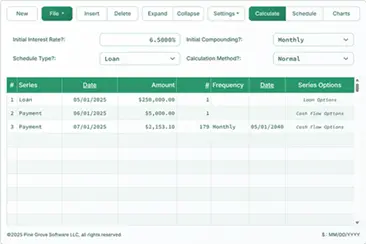How to Calculate Present Value
To change the currency symbol or date format, click the “$ : MM/DD/YYYY” link in the lower-right corner of any calculator.
A Step-by-Step Tutorial
Tutorial 20
Present value is a critical financial concept.
Investors use present value (PV) to evaluate the worth of future payments when considering a mortgage or loan. Attorneys apply it to assess the current value of future cash flows in legal settlements. Wikinvest defines present value as “today’s value of a set of cash flows that will occur in the future. It is calculated by dividing future cash flows by an appropriate discount rate.” The Ultimate Financial Calculator is designed to calculate present value for any cash flow scenario.
All users should complete the more detailed first tutorial to understand the basic concepts and settings of the Ultimate Financial Calculator (UFC).
Assume you have won a lottery. The lottery commission gives you two options:
- Receive monthly payments of $35,045.00 for 20 years, or
- Accept a one-time lump-sum payment of $5,476,123.50.
To compare these options, calculate the present value by following these steps:
- Set Schedule Type to “Savings”.
- Alternatively, click the button to clear all previous entries.
- Set Rounding to “Open balance—no adjustment”.
Select . - In the header section, apply the following settings:
- Set Calculation Method to “Normal”.
- Set Initial Compounding to “Exact/Simple”.
- Set Initial Interest Rate to 5.5.
- This rate represents your expected annual return from investing the lump sum. It is also known as the discount rate.
- In row one of the cash flow input area, create a “Withdrawal” series:
- Set the Date to October 3, 2024.
- Set the Amount to Unknown by typing U. Fig. 1
- Set # Periods to 1.
- Note: Because the number of periods is 1, you will not be able to set a frequency.
- If you attempt to set a frequency, it will be cleared when you exit the row.
- In row two, create the expected series of lottery payments:
- Select “Deposit”.
- Enter the Date as November 1, 2024.
- This is the expected date of the first payment from the lottery commission.
- Enter the Amount as $35,045.00 (periodic winnings).
- Enter 240 for # Periods.
- Select “Monthly” for Frequency. The calculated End Date will be October 1, 2044 (the final payment date).

- Click the button.
- The result is $5,063,030.40. Fig. 2

- Assuming a future cash flow of 240 monthly deposits of $35,045.00 each, the present value is $5,063,030.40. This amount is less than the lottery’s lump-sum offer of $5,476,123.50. Based on value alone, the lump sum appears to be the better option.
Note 1: The cash flow may consist of a single amount or a series of deposits, withdrawals, or payments. You can define multiple series if needed. When calculating present value, the first entry must be set to “Unknown”. The Date should be set to today, and the Series should be opposite to the future cash flow series.
Note 2: This example does not account for taxes. Taxes can significantly affect the outcome. Consult a qualified tax professional before making a financial decision.
Note 3: This example also does not address investment risk. If you accept the lump sum, are you confident that you can invest it to match the total value of the future payments? If you choose the monthly payments, is there a risk that the provider may not make every payment? If future payments are uncertain, accepting a smaller lump sum may be safer.
Back to the Ultimate Financial Calculator.
